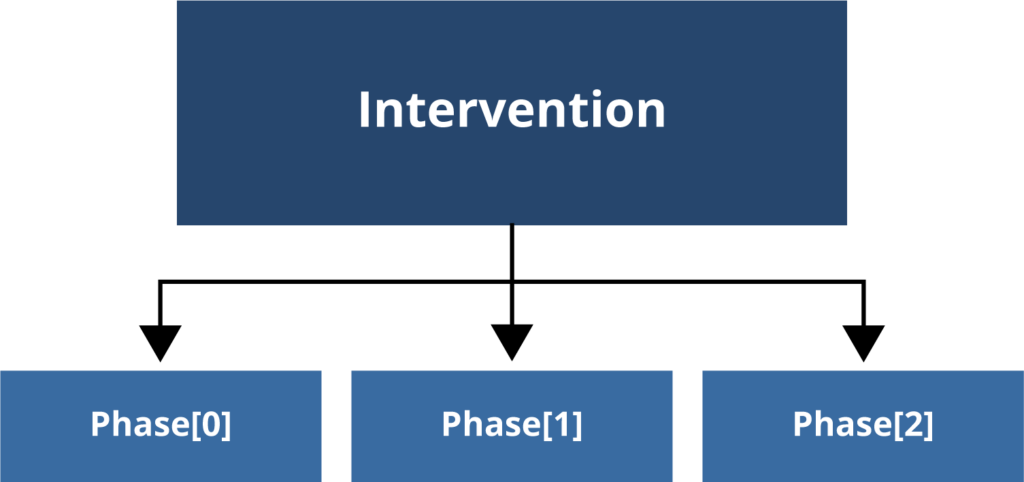Conceptual Model and Methodology
Fulcrum Impact
Interventions and Phases
Interventions can take many different forms, including domain-specific interventions such as Clinical Programs, Training Programs, Marketing Campaigns, Incentive Compensation Plans, Store Format Changes, UI Changes, or Pricing Changes.
An Intervention can be implemented in multiple phases, each of which can have their own Eligibility Criteria, Targeting Logic, and/or Treatment Rules. For example, a new program could be rolled out region-by-region and each phase would widen the Eligibility Criteria to include the new geographic region.


Analyses and Methodologies
Several different types of analysis can be performed on an Intervention or Intervention Phase. These analyses are distinguished by the questions they attempt to answer. Evaluations attempt to determine whether Interventions “worked” by quantifying their Impact. Other types of analysis attempt to answer the question of how or why an Intervention “worked”, providing input to the optimization of the Intervention or the design of future Interventions. Finally, certain types of analyses run across Interventions and attempt to either learn from them in combination or attribute treatments effects to them.
Each type of analysis can have one or more methodologies that support it, the appropriateness of which is determined by the specific characteristics of the Intervention.
Fulcrum Impact Modules
Fulcrum Impact is an application composed of Modules that, together, bring consistency, repeatability, accuracy and efficiency to the analysis of Interventions.
The process starts with generating Features that will be used in the analysis. Features are data elements associated with a subject at a certain moment in time. Features have a “window” of time associated with them (e.g. total costs over trailing six months) in addition to their “as-of-date”.
Feature Repository
The Feature Repository Modules simplify the data preparation process. By specifying information regarding the features to be generated in a single file, the user has flexibility to modify and add features without changing underlying parameters throughout their workflow.
Feature Package
A Feature Package stores all feature metadata. It provides an efficient, accurate way to store and transfer feature definitions that can be reused to generate/process data at a different time, or on a different dataset.
Feature Generators
Feature Generators transform and combine data features from various data sources into one dataset. Fulcrum Impact provides a variety of Feature Generators for data prep tasks of different complexity from a single column append to advanced statistical transformation.
Feature Provider
The Feature Provider manages the entire feature file creation and computation. Unlike traditional data processing steps that are limited to only one data source type or data processing type, Feature Provider automatically activates the corresponding Feature Generators for each feature, and creates all the feature values to form a processed data set in a single step.
Feature Explorer
The Feature Explorer provides exploratory data analysis functionalities to help users extract insights from features, detect anomalies and outliers, test model assumptions and decide whether a feature or a set of features need to be updated or transformed before feeding them into an analysis.
Analysis Module
There are many types of analyses that can be used to measure Intervention effectiveness. The Analysis Module supports multiple methodologies for different types of analyses, allowing users to compare and choose a methodology. Built-in modeling methodologies included in Fulcrum Impact include:
Matched Case Control
Matched Case Control is often used in case-control studies to ensure that the cases and controls are similar in important characteristics.
Counterfactual
Counterfactual is a popular model-based alternative methodology to measure the impact of the treatment. A variety of modeling methodologies (GLM, etc…) are available for users to choose.
Model Assumption Checking
Model Assumption Checking is a built-in utility to check key underlying assumptions for linear models. It can be used independently if users choose to use a more organic linear model based methodology.
Reporting Module
The Reporting Module templates produce HTML views of objects for use in web applications and Jupyter Notebooks, as well as other types of views for reports and data visualizations. Data points generated in previous analysis steps, such as in the Feature Explorer, can be reused for reporting in formats such as Excel or PowerPoint.
HTML
HTML populates an html page and displays result in-line in the notebook. Styling and format can be modified from a CSS file, which is customizable depending on the requirements.
Excel
Excel generates a downloadable .xlsx file in the defined path.
PowerPoint
PowerPoint generates a downloadable .pptx presentation with a download button in-line in the notebook.
Dashboards
Dashboards can be designed with a customized Jinja template. Once configured, the dashboard will be automatically rendered with corresponding components.
Basic
All the benefits of Fulcrum Impact
- Full access to Fulcrum Impact and all features
Hosted
Fulcrum Impact with Managed Hosting
- Full access to Fulcrum Impact and all features
- Hosted in Fulcrum’s secure data environment
- Customized features and tools for your business
Expert
Fulcrum Impact with a team of experts
- Full access to Fulcrum Impact and all features
- Full Data Science consulting team for hands on approach and training
- Customized features and tools for your business

Fulcrum creates apps that put your data to work and make a meaningful impact on the efficiency of your business. Fulcrum can host these apps for you, or build the apps for you within your own environment. In all cases, the applications we build have the same goal: to put the power of data at your fingertips for better business decision making.